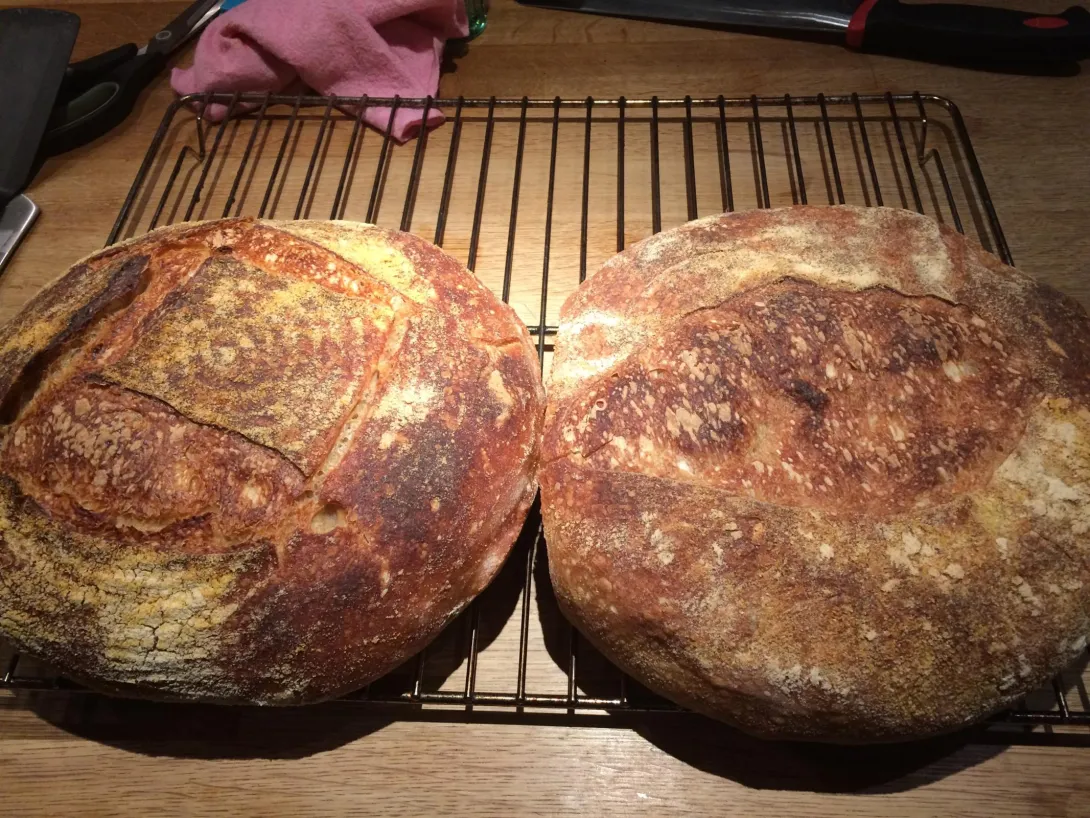
Hello everybody,
I have just taken breads out of the oven. Based on Tartine Bakerys recipe with 18 hour retarding in refrigerator for final proofing. The taste is very good and perfect balance.
As you can see from the image attached, the loafs did not rise that much in the combo cooker - the one on the left was taken straight out of the fridge an into the cool cooker. The other one was put into the cooker when it was hot and that loaf also had 45 min on the counter before going into oven.
The one with a warm cooker and a 45 min rest in 20 celcius, was looking ok and turned out to be the best and also had the best rise doing baking.
Does anyone of you have a good tip on how to get more rise in the oven ?
Thanks, peter
I see that you mentioned the Tartine recipe, could you post the details?
Also, what breand of flour did you use?
Lastly, a major component of good oven spring is gluten development and tension. Did yOU GET "windowpane' in your dough? How do you shape the dough?
Yes, it's a long learning process.
-Dave
over proofed in the fridge for 18 hours. If I go past 12-15 hours, even with a small 11% levain. the shaped dough will over proof and spread rather than spring, In the summer time I reduce the proof to 8-10 hours with no bulk ferment or the dough over proofs.
I'm doing a 40% whole sprouted rye bread today for a shaped proof in the fridge at 11% levain and it will be in the fridge for 15 hours, with no bulk ferment, and I'm betting that it will over proof with so much sprouted rye. it is the nature of this beast..
You got some bloom so it also might be a gluten development and shaping issue
I vote for overproofed. Getting the timing right on the final proofing/retard is one of the trickier "gotchas" in the world of levain nurturing.
I've settled on a proof time of 55 minutes at 82.4 dF before retarding at 38 dF for 12 hours for a 30% leavain using organic flour from Central Milling bulk fermented for 2.5 hours at 82.4 dF prior to weighing and shaping.
The "knack" is to catch the rising dough at just the right time such that it just finishes proofing while under the retarding refrigeration. That's why keeping time and temperature tabs on the dough is so important.
I use post-its to record a snapshot of "where the dough is at" - this takes some of the human fallibility out of the equation.
One item that I have found invaluable is a non-contact infra-red thermometer for measuring temperature. I don't know what I''d do without it now...,
Thanks for the comment - and you're probably right. I will now try retadring for 8 hours and do the first proof time at 82,4 before going into the refrigerator.
Interresting with the temp/time measurement. When do you know when the proof time is finished - what temperature are you looking for ?
Peter
"When do you know when the proof time is finished - what temperature are you looking for ?"
That's the knack. It is not finished proofing when put under refrigeration. That's why maintaining 82.4 dF and timing at 55 minutes becomes so important. If the dough is proofed too long it will overproof in the refrigerator, too short and it will not yield a maximum oven spring. Complicating all this is the particular starter's rising capability and the constituency of the dough. It calls for experienced and experimental guesswork...,
Wild-Yeast